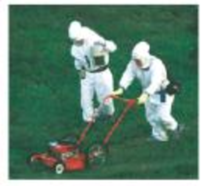
Nightmare on the Island

Peggy loves her time on The Island each year. Her parents had taken her every year to the resort destination as a girl, and now she is doing the same with her children. Their seaside home near Cape Cod, Massachusetts, is modest in comparison to some of the neighbors’, but it has been in Peggy’s family for over a hundred years, and she has fond memories from every stage of her life. One of Peggy’s fondest memories is playing tag with her friends on the lawns of The Island’s homes. Now, she smiles as she watches her eight-year-old son, Jacob, help the older son of one of her childhood girlfriends mow the grassy expanse. “Building memories- that’s what it’s about ,” she muses. Little does she know that some memories can build nightmares.
Three days later Jacob wakes up complaining of a scratchy throat, headache, and “soreness all over.” Peggy is concerned about his dry cough and 103°F temperature. “A summer cold?” she wonders. She keeps Jacob in bed, which isn't difficult because his breathing becomes more labored and painful. Two days later he begins coughing up blood, and Peggy recognizes that this isn’t an ordinary summertime cold.
She rushes Jacob to the local clinic, where the doctor orders immediate intravenous streptomycin and transport to a hospital on the mainland. The physician tells Peggy that Jacob is likely infected with the most virulent bacterium known. He questions her about Jacob’s activities on the island: Has the boy touched any animals? Done any outdoor activities? Been bitten by a tick? “No, no, no.” Then she recalls that Jacob helped mow the grass earlier in the week.
Within days, Jacob feels better and can answer questions. He tells the doctor that the lawnmower had run over the dried body of a small dead rabbit. The physician suspects the mower had spewed bacteria into the air; Jacob had inhaled a near-fatal dose.
The grassy lawn will no longer recall the fond memories of Peggy’s childhood; instead, she will remember men in biohazard suits taking samples, documenting the nightmarish time she almost lost her son.
- 1. What bacterium infected Jacob?
- 2. What is a common name of the disease afflicting Jacob?
- 3. What do the laboratory scientists at the hospital determine about the Gram reaction of the bacterium?
- 4. Why didn’t the physician use penicillin instead of streptomycin?
Want to see the full answer?
Check out a sample textbook solution
Chapter 21 Solutions
EBK MICROBIOLOGY:W/DISEASES BY BODY...-
- How is a protein destined for the Endoplasmic Reticulum (ER), imported into the ER? Be concise.arrow_forwardFind out about the organisations and the movements aimed at the conservation of our natural resources. Eg Chipko movement and Greenpeace. Make a project report on such an organisation.arrow_forwardWhat are biofertilizers and mention the significancearrow_forward
- PCBs and River Otters: Otters in Washington State’s Green-Duwamish River have high levels of polychlorinated biphenyls (PCBs) in their livers. PCBs can bind to the estrogen receptors in animals and disrupt the endocrine system of these otters. The PCBs seem to increase the estrogen to androgen ratio, skewing the ratio toward too much estrogen. How would increased estrogen affect the river otter population? Based on your reading of the materials in this unit, what factors can affect fertility in humans? Explain how each of the factors affecting human fertility that you described can disrupt the human endocrine system to affect reproduction.arrow_forwardOther than oil and alcohol, are there other liquids you could compare to water (that are liquid at room temperature)? How is water unique compared to these other liquids? What follow-up experiment would you like to do, and how would you relate it to your life?arrow_forwardSelection of Traits What adaptations do scavengers have for locating and feeding on prey? What adaptations do predators have for capturing and consuming prey?arrow_forward
- Competition Between Species What natural processes limit populations from growing too large? What are some resources organisms can compete over in their natural habitat?arrow_forwardSpecies Interactions Explain how predators, prey and scavengers interact. Explain whether predators and scavengers are necessary or beneficial for an ecosystem.arrow_forwardmagine that you are conducting research on fruit type and seed dispersal. You submitted a paper to a peer-reviewed journal that addresses the factors that impact fruit type and seed dispersal mechanisms in plants of Central America. The editor of the journal communicates that your paper may be published if you make ‘minor revisions’ to the document. Describe two characteristics that you would expect in seeds that are dispersed by the wind. Contrast this with what you would expect for seeds that are gathered, buried or eaten by animals, and explain why they are different. (Editor’s note: Providing this information in your discussion will help readers to consider the significance of the research).arrow_forward
 Medical Terminology for Health Professions, Spira...Health & NutritionISBN:9781305634350Author:Ann Ehrlich, Carol L. Schroeder, Laura Ehrlich, Katrina A. SchroederPublisher:Cengage LearningUnderstanding Health Insurance: A Guide to Billin...Health & NutritionISBN:9781337679480Author:GREENPublisher:Cengage
Medical Terminology for Health Professions, Spira...Health & NutritionISBN:9781305634350Author:Ann Ehrlich, Carol L. Schroeder, Laura Ehrlich, Katrina A. SchroederPublisher:Cengage LearningUnderstanding Health Insurance: A Guide to Billin...Health & NutritionISBN:9781337679480Author:GREENPublisher:Cengage





